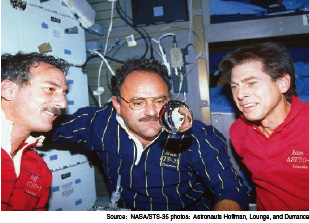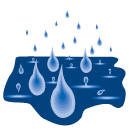

 The remarkable picture to the right was taken aboard the
Space Shuttle. The three enthralled astronauts are looking at a glass
of water--but without the glass. Water has a number of forces that
operate between its molecules. One of those is adhesion. Water will
have an attraction to a material that is of a different molecular
makeup than it is. If you look carefully at a glass of water, you will
see that the water clings to the side of the glass and is raised
slightly. It is this characteristic that allows water to climb up
through the small capillaries in plants so the water can reach the top
of the plant.
The remarkable picture to the right was taken aboard the
Space Shuttle. The three enthralled astronauts are looking at a glass
of water--but without the glass. Water has a number of forces that
operate between its molecules. One of those is adhesion. Water will
have an attraction to a material that is of a different molecular
makeup than it is. If you look carefully at a glass of water, you will
see that the water clings to the side of the glass and is raised
slightly. It is this characteristic that allows water to climb up
through the small capillaries in plants so the water can reach the top
of the plant.
Another force that molecules of water can exert is cohesion. Molecules of water will cling to each other, and that is why a razor blade can be floated on top of a glass of water if it is done carefully. In the weightlessness of outer space, water can be set free in the space capsule and the cohesive forces will work, but there is nothing to adhere to, so the water becomes a sphere hanging in the weightlessness of space.
It is interesting that matter in the creation exists in four states, and that the liquid state is the least common of those four states. We rarely find liquids in space. The interiors of planets may be in the liquid state, but they are not common. Having a liquid on the surface of an astronomical body is exceedingly rare. A moon of Saturn has a liquid surface of methane; and, of course, the earth has a liquid surface of water, but those are rare situations. Solids are the next most common form of matter in the cosmos, but even solids are rare and exist in very few places. We have a few rocky planets like Earth, Mars, Venus, and Mercury. We also have some moons of our planets that are solid. There are clouds of solid matter in our galaxy, and the asteroid belt between Mars and Jupiter has a great deal of solid material. However, this form of matter is rare compared to the last two forms of matter.
Gases are the next most abundant form of matter in the cosmos, and there is a lot of gas. We not only have atmospheres of planets that are very large, but stars like our sun have a corona which is a gaseous area above the photosphere, the luminous surface. Clouds of gases are also seen in free space. Many of them are massive clouds of hydrogen gas.
However, the most common form of matter in the cosmos is plasma. A plasma is made up of atoms that have had their electrons stripped away from them. We see plasma in florescent lights, where high voltages have removed the electrons. The sun is a huge plasma as are all stars, and massive plasmas exist in various nebulae in space.
It is interesting that the most common form of matter on earth (liquid) is the least common form of matter in the cosmos as a whole. Conversely the most common form of matter in the cosmos (plasma) is the least common form of matter on the earth--with plasmas being seen only in lightning and in the auroras. Man also makes a few in his lights and electronic devices.
 There are many lessons available to
us as we study liquids and work to understand the forces that control
them. Some of them are practical lessons, that may enable us to find
ways to use plasma to solve energy problems and study the composition
of the cosmos. Some of them have to do with appreciating the wisdom and
design that is built into the creation in which we live. When we
understand the cause and nature of plasmas, we realize that life could
not exist without them. Liquids, on the other hand, offer an enormous
potential in not only allowing life to survive, but allowing it to
propagate and be stable in the creation. We live on an incredibly
unique planet, with conditions that are remarkably suited for life. The
more we learn about matter, the states of matter, and the composition
of the cosmos as a whole, the more we can appreciate what God has done,
and see that a wonder-working hand has gone before.
There are many lessons available to
us as we study liquids and work to understand the forces that control
them. Some of them are practical lessons, that may enable us to find
ways to use plasma to solve energy problems and study the composition
of the cosmos. Some of them have to do with appreciating the wisdom and
design that is built into the creation in which we live. When we
understand the cause and nature of plasmas, we realize that life could
not exist without them. Liquids, on the other hand, offer an enormous
potential in not only allowing life to survive, but allowing it to
propagate and be stable in the creation. We live on an incredibly
unique planet, with conditions that are remarkably suited for life. The
more we learn about matter, the states of matter, and the composition
of the cosmos as a whole, the more we can appreciate what God has done,
and see that a wonder-working hand has gone before.
Back to Contents Does God Exist?, MarApr09.